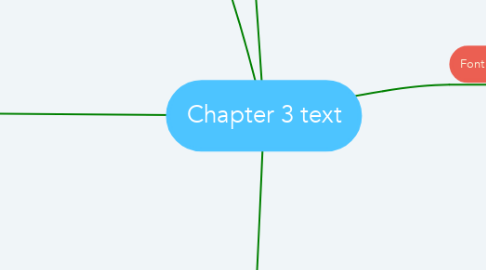
1. Text Elements in a Multimedia Presentation
1.1. text elements used in multimedia
1.1.1. 1. Menus for navigation
1.1.1.1. user navigates through content using a menu
1.1.1.2. simple menu consists of a text list of topics
1.1.2. 2. Interactive buttons
1.1.2.1. button is a clickable object that executes a command when activated
1.1.2.2. create their own buttons from bitmaps and graphics
1.1.3. 3. Fields for reading
1.1.3.1. a hard copy is easier and faster than reading from the computer screen
1.1.3.2. document can be printed in one of two orientations: portrait or landscape
1.1.4. 4. HTML documents
1.1.4.1. stands for Hypertext Markup Language
1.1.4.2. standard markup language used to create web pages
1.1.4.3. documents are marked using tags
1.1.5. 5. Symbols and icons
1.1.5.1. concentrated text in the form of stand-alone graphic constructs
1.1.5.2. used to convey meaningful messages
1.2. commonly used tags
1.2.1. The <B> tag for making text boldfaced
1.2.2. The <OL> tag for creating an ordered list
1.2.3. The <IMG> tag for inserting images
1.3. Choosing text fonts
1.3.1. Use anti-aliased text
1.3.2. Use drop caps and initial caps for accent
1.3.3. Minimize centered text
1.3.4. Use white space
1.3.5. Use animated text to grab attention
2. Computers and text
2.1. bitmap font
2.1.1. consist of a matrix of dots or pixels representing the image
2.1.1.1. File size increases as more sizes are added
2.1.1.2. Require a lot of memory
2.1.1.3. Non-scalable
2.2. vector font
2.2.1. drawing use instructions and mathematical formulae to describe each glyph
2.2.1.1. File size is much smaller than bitmaps
2.2.1.2. TrueType, OpenType and PostScript are vector font formats
2.3. Character sets
2.3.1. the numerical representation of a character
2.3.2. Each character is represented by a unique 7-bit binary code word
2.3.2.1. there are 128 (27) alternative characters
2.4. unicode
2.4.1. 16-bit architecture for multilingual text and character encoding
2.4.2. covers 96,382 characters
2.4.3. support a wide variety of non-Roman alphabets including Han Chinese, Japanese, Arabic, Korean, Bengali
3. Font Mapping
3.1. installed in your machine may not be available in other user’s machine
3.2. Specifying which font to be substitution is called font mapping
4. Hypertext vs hypermedia
4.1. Hypertext
4.1.1. text which contains links to other texts
4.1.2. invented by Ted Nelson around 1965
4.1.3. the subset of hypermedia
4.2. Hypermedia
4.2.1. not constrained to be text-based
4.2.2. can include other media, especially continues media - sound and video
4.2.3. Hypermedia structure
4.2.3.1. Links
4.2.3.1.1. connections between conceptual elements
4.2.3.1.2. the navigation pathways and menus
4.2.3.2. Nodes
4.2.3.2.1. accessible topics, documents, messages, and content elements
4.2.3.2.2. backbone of a knowledge access system
5. Font and Typeface
5.1. Font terminology
5.1.1. 1. baseline
5.1.1.1. bases of character are arranged
5.1.2. 2. cap height
5.1.2.1. refers to the height of capital
5.1.3. 3. x-height
5.1.3.1. distance between the baseline and the top of a lower-case letter x
5.1.4. 4. ascenders/decenders
5.1.4.1. strokes that rise above the x-height/drop below the baseline
5.2. Serif
5.2.1. little decoration at the end of a letter stroke
5.2.2. fonts are used for printed media or documents
5.3. Sans serif
5.3.1. fonts do not have decoration at the end of a letter stroke
5.3.2. used for headlines and bold statements

